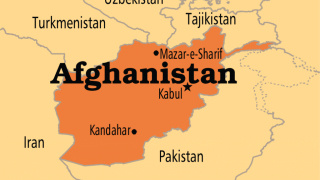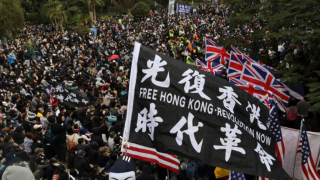The Arctic And The US Air Force
On 21 July, the US Air Force published its Arctic Strategy. The release of the document itself is a first, since the Arctic has never been a separate area of focus for the US Air Force. The Defense Department’s 2019 Arctic Strategy contained a vision of the Arctic as a whole, and it talked about protecting US national interests. The new strategy notes that, along with Europe and the Indo-Pacific theatre, the Arctic represents the third vital link for the US. It is also a key location for global power projection and has considerable natural resources.
The new document points out that the role of the US Air Force in the implementation of national security approaches in the region was previously relatively unknown, but “[g]iven the Arctic’s vast distances and challenges to surface operations, air and space capabilities have long been essential to gain rapid access and provide all-domain awareness, early warning, satellite command and control, and effective deterrence.”
The US Air Force intends to develop its Arctic strategy in four areas, which it calls “Vigilance”, “Power Projection”, “Cooperation”, and “Preparation”. Primarily, we are talking about the preparation of armed forces for future military operations in the Arctic zone.
Against whom is the US Air Force going to use force? The answer is obvious when you consider that all the Arctic countries except Russia are allies and satellites of the US. In a joint article, US Air Force Secretary Barbara Barrett, US Air Force Chief of Staff David Goldfein and US Space Force Chief of Space Operations John Raymond openly state that Russia and China will be likely enemies in the Arctic.
During the Cold War era, the Arctic was regarded by the two superpowers as a strategically beneficial position for a swift nuclear strike. Today, the US has a radar system in Alaska, which, together with more than 50 radars in Canada, makes up an early warning system known as NORAD. The US also has special military bases in Greenland that can track more than 20,000 objects.
Recent activity by the Pentagon suggests that it is attempting to extend its control over the Arctic, including engaging traditional partners.
 The US Air Force’s Arctic Zone area of responsibility
The US Air Force’s Arctic Zone area of responsibility
In 2019, the US Air Force, together with NATO partners as well as Sweden and Finland, carried out the latest Arctic Challenge exercise in the area above Iceland and the Arctic Edge joint training exercise with Canada in North America. They have been carried out before (in 2015, they were actually criticised by Sweden), but 2019 was the first time that they involved neutral Finland.
In July, it also became known that the US Air Force had ramped up its cyber capabilities to full capacity. An official statement issued on 14 July said that “[c]onvergence has brought previously segmented elements in our enterprise together … to synchronize on common operational priorities that cross combatant command boundaries. As we scale and build upon convergence in the information environment and implement material solutions that automate data awareness and sharing … we will begin to generate global outcomes at the speed of the information war.”
In fact, it signifies a new level of intelligence, surveillance, reconnaissance, the use of the electromagnetic spectrum and other information operations and cyberspace assets.
NATO’s military believes that a standing maritime group should be created in the Arctic to check Russia’s growing influence. Due to its current absence, the US Air Force and US Space Forces have apparently decided to take on this role themselves.
There is also the opinion that the most effective direction for US policy in the Arctic region should be the preparedness of existing US expeditionary forces for Arctic operations, rather than the development of security capabilities unique to the region.
If truth be told, however, the US is already actively implementing its Arctic strategy not just on a military level, but on a diplomatic one, too. The Air Force’s new strategy will also serve as a catalyst for existing processes.
On 9 June 2020, the US president issued a Memorandum on Safeguarding US National Interests in the Arctic and Antarctic Regions. It recognised the need to create a fleet of icebreakers (at least three) to operate in polar waters. The review, including budgeting, has been entrusted to the Department of Homeland Security, in coordination with the Department of Defense, where the US Secretary of the Navy will play a leading role in the project. The US Department of Energy will also carry out an expert review. The report should be ready sometime within the first ten days of August 2020. Two months is not very long for such a review, which suggests a certain amount of haste.
On 22 July, US State Secretary Mike Pompeo visited Denmark to discuss common military and economic policies in the Arctic and North Atlantic with the country’s prime minister and foreign minister. Representatives of Greenland and the Faroe Islands were also present at the meeting.
Trump’s offer to purchase Greenland from Denmark, announced back in 2019, is also part of America’s plans for the Arctic, although, at the time, Danish authorities regarded it as an act of provocation and refused Washington, following which all scheduled meetings were cancelled.
 In June 2020, the US reopened its consulate in Greenland, and $12 million in economic aid has helped to smooth over the “island sale” incident.
In June 2020, the US reopened its consulate in Greenland, and $12 million in economic aid has helped to smooth over the “island sale” incident.
Patriotic forces within Denmark are worried that the US is stepping up its “soft-power” tactics and engaging its full range of lobbyists, from such heavyweights as former NATO Secretary General Anders Fogh Rasmussen to various US-oriented non-governmental organisations. At the same time, new consulates in Greenland and the Faroe Islands will enable America’s point of view to be imposed more effectively, including the encouragement of hostile policies with regard to Russia and China. It could even lead to the gradual alienation of these territories from Denmark later on, right up to an act of separatism.
The US is concerned about the development of Russian military bases in the Arctic Circle, which is emphasised in the US Air Force’s new strategy. The document also notes that 25 per cent of Russia’s GDP is linked to the Arctic region (oil and gas exports). The development of Northern Sea Route infrastructure and the transfer of energy resources to China from Russia’s sea ports in the north are interfering with US plans to establish an energy monopoly and undermining efforts to destroy the Russian economy. Using the Northern Sea Route also significantly reduces transit times from the largest Asian port in Shanghai to the largest European port in Rotterdam. In 2018, China included the Northern Sea Route in its global “Belt and Road” communication project. Since the US began its confrontation with Russia and China, interaction between these two countries is actually creating a strong alliance, where each feels it can rely on the other for support should the conflict with America worsen.
Reading between the lines of the new strategy, it is clear to see that the US wants to limit cooperation between Russia and China on the one hand, and between the countries of Western Europe and Canada on the other.
Previously, the basic principles of Russia’s state policy in the Arctic up to the year 2035, approved in March 2020, also provoked a nervous reaction in the US. In particular, a recent NATO study on the subject stated that Russia’s new approach to its activities in the Arctic deserve serious attention, especially given that Russia will be chair of the Arctic Council in 2021.
Since the new strategy relates to the US Air Force and Space Force, any activity by rival powers in the air or in space will be roundly condemned by Washington. Thus, the US instantly described the new Cosmos 2543 satellite launched by Russia as Moscow’s new anti-satellite weapon. There is no doubt that such speculation will be used by war hawks in the US and NATO countries and provoke another round of the arms race.









